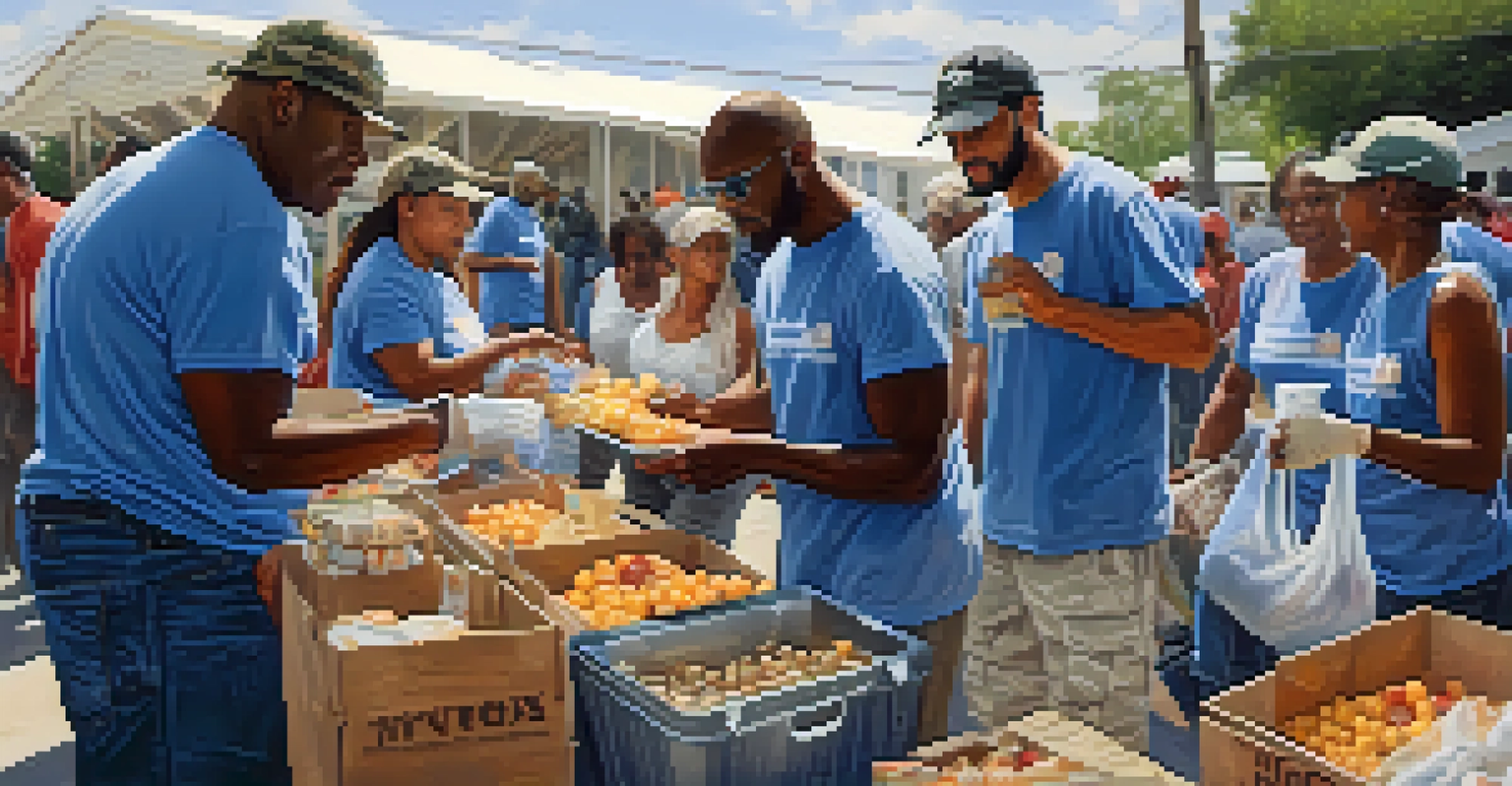Hurricane Katrina: A Defining Moment in New Orleans History

Understanding Hurricane Katrina's Origins and Path
Hurricane Katrina formed over the Bahamas in August 2005, quickly gaining strength as it moved toward the Gulf Coast. With winds reaching up to 175 mph, it became one of the most powerful hurricanes in recorded history. As it approached New Orleans, the city braced for impact, but no one could predict the devastation that was about to unfold.
Our greatest glory is not in never falling, but in rising every time we fall.
On August 29, 2005, Katrina made landfall, bringing torrential rain and storm surges that overwhelmed the levee system. The water surged into neighborhoods, flooding homes and displacing thousands of residents. This catastrophic event was not just a weather phenomenon; it was a wake-up call about the vulnerabilities of coastal cities.
As the storm passed, the extent of the damage became clear. New Orleans was left in ruins, with entire communities submerged and the city's infrastructure crippled. This moment marked the beginning of a long and arduous recovery process that would redefine the city and its people.
The Immediate Aftermath: Chaos and Displacement
In the days following Katrina, New Orleans was engulfed in chaos. Emergency services struggled to respond amid the rising floodwaters, leaving many residents stranded and desperate. The images of people clinging to rooftops and seeking refuge at the Superdome became synonymous with the disaster, highlighting the dire need for effective crisis management.

As evacuation efforts ramped up, countless families were uprooted from their homes. Many were forced to relocate to shelters across the country, creating a sense of loss and disconnection. This mass displacement was not just about losing property; it was about severing ties to a community and way of life that had existed for generations.
Katrina Exposed Disaster Vulnerabilities
The catastrophic impact of Hurricane Katrina revealed significant flaws in emergency management and preparedness across local, state, and federal agencies.
The emotional toll of Katrina was profound. Survivors faced the daunting task of rebuilding their lives, often with limited resources and support. This period of uncertainty laid the groundwork for a long journey of recovery, resilience, and community rebuilding.
Government Response: A Lesson in Preparedness
The government's response to Hurricane Katrina has been widely criticized and serves as a crucial lesson in disaster preparedness. Many felt that local, state, and federal agencies were unprepared for such a catastrophic event, leading to delays in rescue efforts and aid distribution. This response exposed significant flaws in emergency management systems.
The future belongs to those who believe in the beauty of their dreams.
In the aftermath, investigations revealed communication breakdowns and a lack of coordination among agencies. The Federal Emergency Management Agency (FEMA) faced intense scrutiny for its slow response, which fueled public outrage and demands for accountability. This scrutiny highlighted the need for better planning and resource allocation.
Katrina prompted a national conversation about disaster preparedness and response. As a result, policies and systems have been revised to ensure more effective coordination in future emergencies. This experience has become a case study for other cities at risk of similar disasters, emphasizing the importance of proactive measures.
The Humanitarian Efforts: Communities Coming Together
In the wake of the devastation, local and national communities stepped up to provide humanitarian aid to those affected by Katrina. Volunteers from across the country flooded into New Orleans, offering their time and resources to help with recovery efforts. This spirit of solidarity showcased the resilience of the human spirit in times of crisis.
Organizations like the Red Cross and local charities mobilized quickly, providing food, shelter, and medical care to displaced residents. The outpouring of support highlighted the importance of community and the willingness to help one another in the face of adversity. These efforts played a crucial role in the immediate recovery process.
Community Resilience Shines Through
In the aftermath of the hurricane, the spirit of solidarity and humanitarian efforts played a crucial role in helping displaced residents recover and rebuild their lives.
As New Orleans began to rebuild, the significance of these humanitarian efforts became clear. They not only provided necessary support but also fostered a sense of hope and unity among survivors. This collective action laid the groundwork for long-term recovery and revitalization of the city.
Cultural Impact: A Shift in New Orleans' Identity
Hurricane Katrina profoundly impacted the cultural landscape of New Orleans, reshaping its identity in the years that followed. The storm displaced many artists, musicians, and cultural figures, leading to a loss of cultural heritage and traditions in some areas. This shift raised questions about the preservation of the city's unique character.
However, as residents returned and rebuilt, they brought renewed energy to the cultural scene. Festivals, music, and art became symbols of resilience and recovery, reflecting the spirit of a community that refused to be defeated. The city’s culture evolved, incorporating new influences while honoring its rich history.
Katrina also sparked a broader conversation about social justice and equity in cultural representation. Many artists used their platforms to address the challenges faced by marginalized communities, ensuring that their voices were heard. This cultural renaissance became a vital part of New Orleans' recovery narrative.
Economic Recovery: Challenges and Opportunities
The economic impact of Hurricane Katrina was devastating, with businesses destroyed and unemployment rates skyrocketing. The road to recovery was fraught with challenges, as many residents struggled to find work and rebuild their livelihoods. The storm exposed vulnerabilities in the local economy, prompting a re-evaluation of economic strategies.
Despite these challenges, the recovery process also presented opportunities for growth and innovation. As businesses reopened, there was a push for sustainable practices and new industries to emerge. This shift aimed to create a more resilient economy that could withstand future disasters.
Cultural and Economic Transformation
Hurricane Katrina not only reshaped New Orleans' cultural identity but also prompted new economic strategies aimed at creating a more resilient local economy.
The rebuilding efforts attracted investments and initiatives focused on revitalizing the city. Programs aimed at supporting local businesses and fostering entrepreneurship played a crucial role in economic recovery. This blend of challenge and opportunity defined the post-Katrina economic landscape.
The Legacy of Hurricane Katrina: Lessons Learned
Hurricane Katrina left an indelible mark on New Orleans, shaping its future and the lives of its residents. The lessons learned from this disaster extend beyond the city limits, serving as a reminder of the importance of preparedness and resilience in the face of adversity. Many communities have since implemented measures to enhance their disaster response capabilities.
The legacy of Katrina also encompasses the spirit of unity and determination displayed by those who survived and rebuilt. It stands as a testament to the power of community and the ability to rise from the ashes of tragedy. New Orleans has become a symbol of resilience, inspiring other cities to prioritize recovery and preparedness.

As we reflect on the events of 2005, it’s crucial to honor the memories of those who lost their lives and acknowledge the ongoing challenges faced by many survivors. The story of Hurricane Katrina is not just about destruction; it's about hope, strength, and the enduring spirit of a city that continues to thrive against the odds.